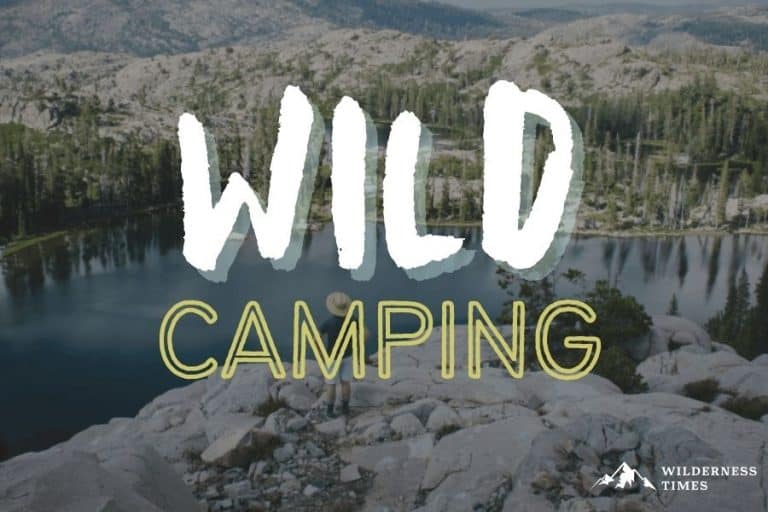All camping trips will bring you closer to nature.
But, if you really want to get back to nature – wild camping is the way to do it.
Still, a wild camping trip is a far more complex mission than a camping trip at a developed campground.
Don’t worry, though. All you need for a successful trip is the right information and proper planning.
That’s where I come in.
In this article, I’ll tell you everything you need to know before you go wild camping. From planning a trip, to gear and safety advice, to minimizing your impact on the environment.
Ready to find out more?
Let’s dive in!
Table of Contents
ToggleThe Beauty Of Wild Camping
Let me just start by saying that I’d rather go wild camping (otherwise known as free camping or dry camping) than stay at a campground any day of the week.
I get that some people are attracted to the convenience of developed campgrounds. And sure, having access to running water and electricity does make things easier, I’m not gonna lie.
But, in my opinion those perks have nothing on the perks that wild camping offers.
There’s no better way to reconnect with Mother Earth than going deep into the wilderness, far away from civilization. Only then can you truly experience the tranquility and breathtaking beauty of nature in its entirety.
And anyway, there are plenty of ways that you can still have clean water, electricity, and everything else you need on a camping trip. You just have to be a little bit more organized and make sure to have a solid plan in place before you go.
We’ll discuss how you can do that in greater detail a little bit further down.
On a side note, if you’re a beginner camper, you might want to stay at developed campgrounds on your first few trips, until you find your groove.
Where Can You Go Wild Camping Legally?
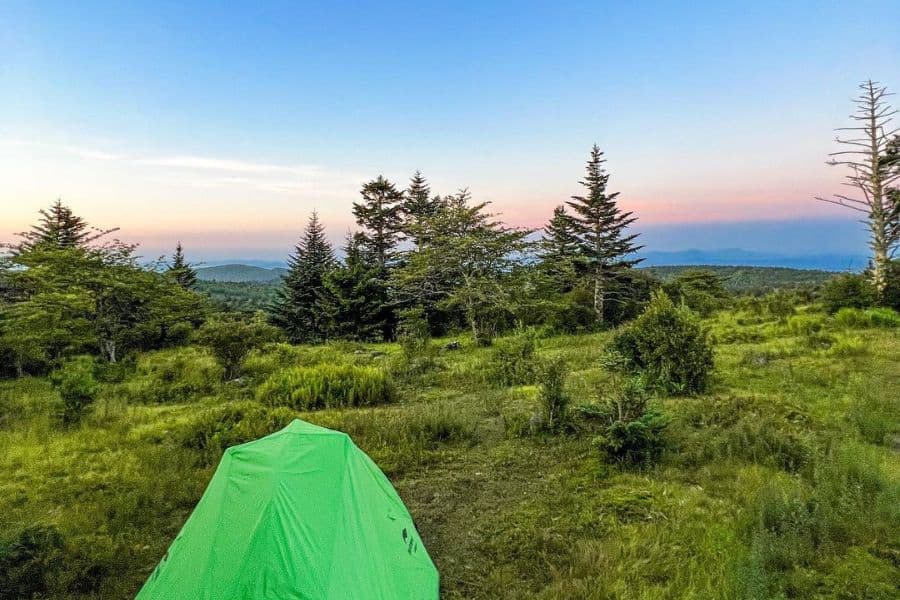
Before you go making any grand plans, you need to make sure that you’re legally allowed to camp at the location you’re planning to visit.
Wild camping laws differ from place to place. So, you should always research your destination thoroughly to make sure you’re not violating any local regulations.
In The US & Canada
As far as the US and Canada go, wild camping is legal in most places.
Unless specifically marked otherwise, you can set up camp in national forests and grasslands in the US, and on Canadian Crown Land. You don’t even need a permit.
You can also camp out in the backcountry of national parks and monuments. For this, however, you do need a permit in some cases. So, make sure you find out before you go and get a permit sorted on time if you need one.
Regulations might also apply for things like campfires, campsite locations, and local flora and fauna. Make sure to get acquainted with these before you head off on your trip.
Also See: What is Dispersed Camping?
Internationally
When it comes to wild camping abroad, the laws vary greatly from place to place.
In some countries, like Turkey, Sweden, and Nepal, wild camping is completely legal, and you’re allowed to set up camp wherever you like.
On the opposite end of the spectrum, other countries, like Australia, Thailand, and Greece, don’t allow free camping at all.
If you set up camp outside of an established campground in these countries, you could end up getting a hefty fine. Not to mention a very unpleasant awakening, and I say this from experience.
I spent a couple of weeks camping on the Greek peninsula of Sithonia with my boyfriend two summers ago. We spent a few nights at a campground, and then we decided to try sleeping out on the beach one night.
We knew that wild camping was illegal in Greece, but we figured if we put our air mattress down without a tent, it wouldn’t really count as camping and we’d be fine.
And it was absolutely amazing. We loved it so much that we decided to sleep out on the beach the next night as well.
Except, we didn’t count on it suddenly starting to rain in the middle of the night.
Not wanting to sleep in the car, we decided to quickly grab our tent and frantically shuffled to set it up as quickly as possible. Early in the morning, I heard the sound of a car engine stopping. The road wasn’t that close, so I could tell the car was on the beach.
Sure enough, I peered out of the tent only to see 3 police officers walking directly towards us. We ended up getting fined around $360. Definitely not the happiest morning of our vacation.
Planning A Wild Camping Trip
Once you’ve made sure that free camping is allowed in the place you want to go, it’s time to start planning your trip.
But, where do you begin?
There are 3 main things you need to ask yourself:
- Where am I going to set up camp?
- What do I need to pack?
- And, what will I eat and drink during the trip?
Finding A Campsite
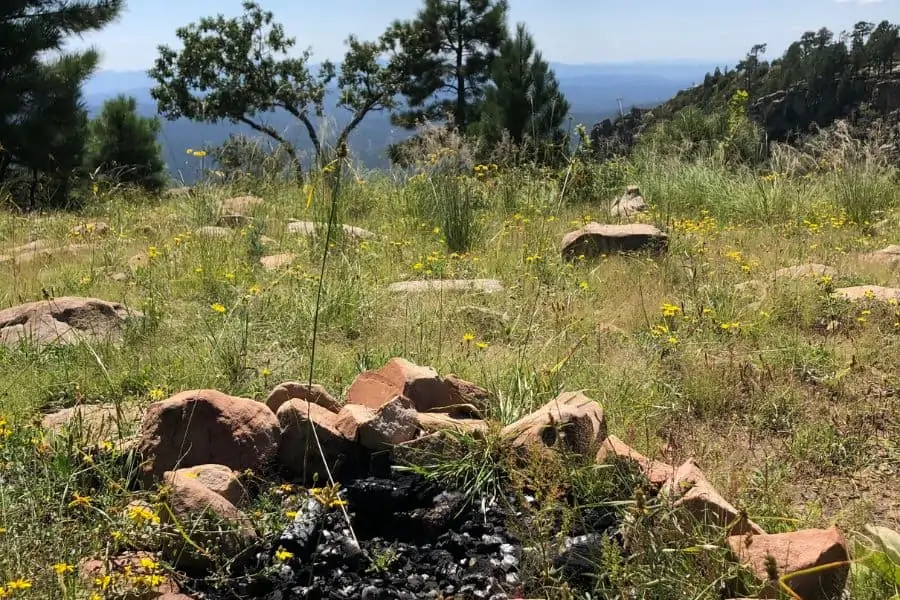
Like I said, there are plenty of national parks, monuments, forests, and grasslands where you’re free to set up camp. Contact the park you plan on visiting before you go to find out which areas are fair game.
Once you arrive at your destination, you can start looking around for the perfect spot.
There are a few things you should look out for when selecting a campsite.
First of all, you want it to be as flat and even as possible. Make sure there isn’t anything sharp on the ground that can’t be easily removed.
Try and find a spot on higher ground, because there will be less moisture. This means you’ll be less likely to have problems with condensation in your tent. If you camp too close to a body of water, you could wake up in the morning to find all of your stuff wet.
And anyway, camping less than 200 feet away from water goes against the Leave No Trace organization’s 2nd principle.
Finally, try and find a campsite that has natural shade throughout the day.
But, be careful of hanging tree branches that might break off and fall. A tree branch falling onto your tent can be extremely dangerous. So, it’s important to remember to take a good look at the trees around you before you set up camp.
If you can’t find a spot with natural shade, you can use a camping tarp to set up a shelter, to give your tent some extra protection from the elements.
Essential Gear To Pack
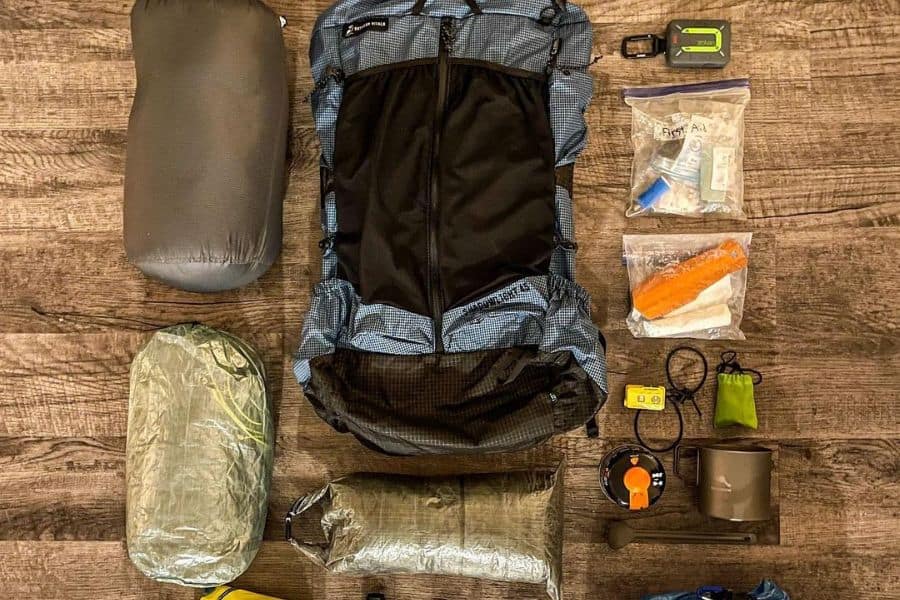
Here’s a checklist you can use to make sure you’ve packed everything you could need on a wild camping trip:
- Food and water
- Some form of shelter
- Bedding
- Appropriate clothing
- Camp furniture (chairs, tables, etc.)
- Personal hygiene products
- A solar shower bag
- Biodegradable soap
- Bug repellent
- Zip bags and garbage bags
- Biodegradable toilet paper
- A trowel
- Firewood and a fire starter
- A camping stove and fuel
- A flashlight and batteries
- A map and compass
- A cell phone
- A first aid kit
Your shelter can be a tent, but it can also be a hammock or a bivvy bag. Which type of shelter you decide to use is entirely up to your own personal preference.
The bedding you take will depend on the type of shelter you’re using. A sleeping pad and sleeping bag are the basics, and you can use them in all three types of shelter.
However, if you’re sleeping in a tent you can use an air mattress instead of a sleeping pad, if you like.
And, if you’re sleeping in a hammock you might also want to pack an underquilt, a top quilt, and a special sleeping pad designed for hammocks. Although, a regular sleeping pad will also work, in case you haven’t got one.
The type of clothing you pack will depend largely on the weather. If it’s cold, you’ll need to master the art of layering to stay warm. But, if it’s hot, you still want to take some light clothing that covers most of your skin, to protect yourself from the sun.
When it comes to protecting yourself from mosquitoes and other bugs, you have a couple of options. You can either get some bug spray, burn some coils, or use natural repellents like vinegar and essential oils.
Keeping Yourself & Your Surroundings Clean
You might be worried about how you’re going to stay clean with no running water. Don’t be.
It might seem like an issue, but this one is actually super easy to solve.
All you need is a solar shower bag, and you can shower just like you would at home. Just make sure to use biodegradable soap that won’t damage the local ecosystem.
If you want a little bit of privacy, you can grab yourself a shower tent. That way, you’ll have a private little cubicle that you can bathe in, hidden away from your camping buddies.
Honestly, if there’s a lake or river near your campsite you can skip the shower bag and just have a quick swim to get yourself clean. For shorter trips especially, this will be more than enough.
Hang on though, what about “when nature calls”?
Don’t worry, there’s an easy fix for that as well.
For number 1, all you need to do is distance yourself a bit from your campsite. This is so that you don’t attract any bears or other animals.
And, remember how I said you need to pack a trowel? Well, that’s for number 2.
Use your trowel to dig a cat hole. Once you’ve done your business, throw your biodegradable toilet paper into the cat hole and bury it.
If you’re using wet wipes or sanitary products that aren’t biodegradable, pack them out in zip bags and double bag them. Pack them away and dispose of them when you get back to civilization.
Easy as that!
What About Food & Water?
Let’s go back to the top of our essential gear checklist – food and water.
There’s a reason I put this at the top of the list. It’s the single most important thing you need to take care of when you’re organizing a wild camping adventure.
Depending on where you’re going, there’s a good chance you won’t have any stores nearby. So, you need to make sure you have enough supplies to last you the duration of your trip.
Food
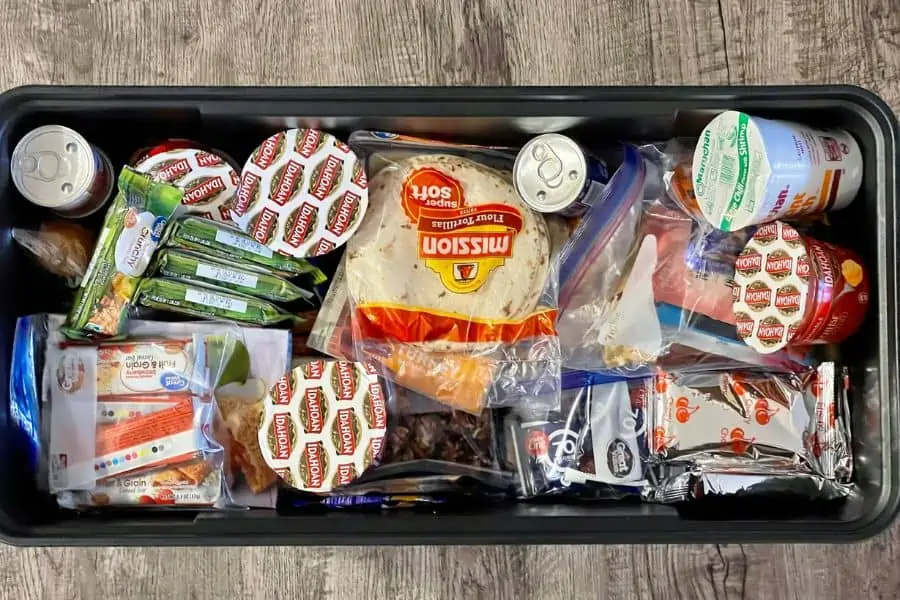
When it comes to food, it’s a good idea to take a cooler or two. However, keep in mind that once your ice has melted, the perishables inside your cooler will start to go off. So, you’ll need to use them up within the first couple of days of your trip.
After that, you’re left with non-perishables. Don’t worry though, there are plenty of great things you can eat on your trip that don’t need to be refrigerated. Or cooked, for that matter.
If you’ve got an electric cooler that runs on a generator, or your car – it’s a whole other story. You can bring whatever you like and keep it fresh and cold throughout your entire trip.
In any case, always make sure to take an ample supply of non-perishable back up meals. You just never know when something could malfunction, and you don’t want to find yourself in the middle of the woods with nothing to eat.
Water
As far as water goes, you’ve got 2 options:
- Taking enough bottled water to last you the entire trip
- Bringing some type of water purification system and sourcing water
If you’re backpacking then you definitely won’t be able to carry enough water to last you the entire trip. In that case, you’ll have to go with the second option.
Don’t worry, though. Purifying water that you source from nearby streams, lakes and rivers isn’t difficult.
There are a few ways you can do it.
Water purification tablets are one option. These contain chlorine, which kills off any pathogens in the water. On the downside, it also leaves a swimming pool taste that isn’t too pleasant.
Another option is purification straws. These are really neat. You just drink water through the straw, and by the time it reaches your mouth it’s clean. You can even drink it directly from the stream, river or lake.
But, at the end of the day, if you find yourself in need of clean drinking water and you haven’t got any of these things – you can always just boil it. Let it boil for a minute or two, and once it cools you can safely drink it.
Emergency Supplies
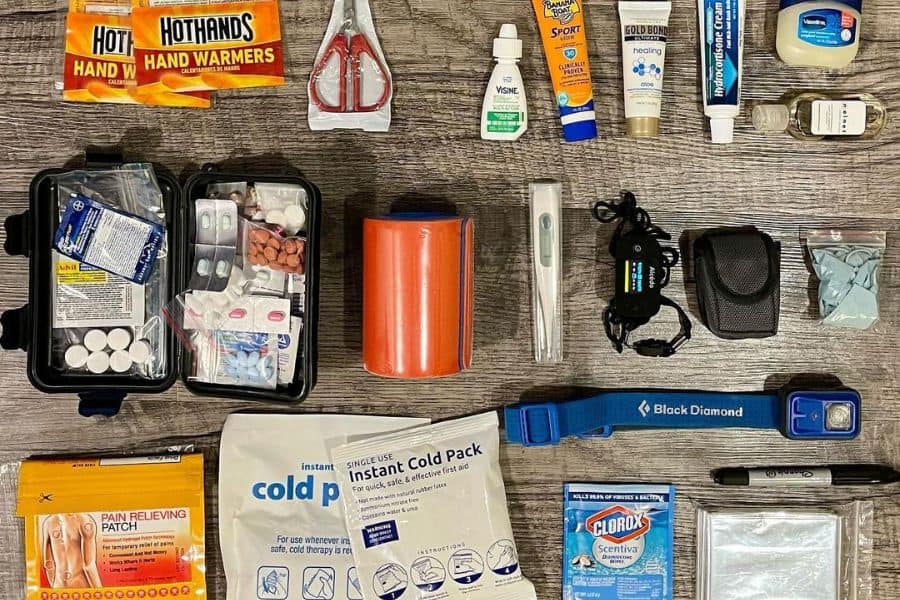
When you’re out in the wilderness, anything can happen.
Hopefully nothing does, but it’s always a good idea to be prepared for the worst. Chances are you’re probably quite far from the nearest city, so you need to make sure you have some basic emergency supplies with you.
This includes things like a first aid kit, a flashlight, batteries, a whistle, a map and compass, and a fully charged cell phone.
It’s also a good idea to have some basic first aid skills and knowledge, in case someone gets hurt while you’re out in the middle of nowhere.
A map and compass might seem old school, and you might think you don’t need them, what with your cell phone and GPS. But trust me, none of your devices are as reliable as a compass. If all your batteries run out and you can’t find your way out of the wilderness, you’ll be glad you have a map and compass to jump to the rescue.
And if you don’t already know, learning how to use a compass before you go wild camping is definitely a good idea.
On the flipside, I know a lot of people go camping to get away from technology for a few days or weeks, and you might even be tempted to leave your cell at home.
Don’t.
You could need it, so charge it, turn it off, and pack it just in case. Even if you’re camping in an area with no service, you can still find the nearest place with service and make a call in an emergency.
3 Wild Camping Tips To Keep In Mind
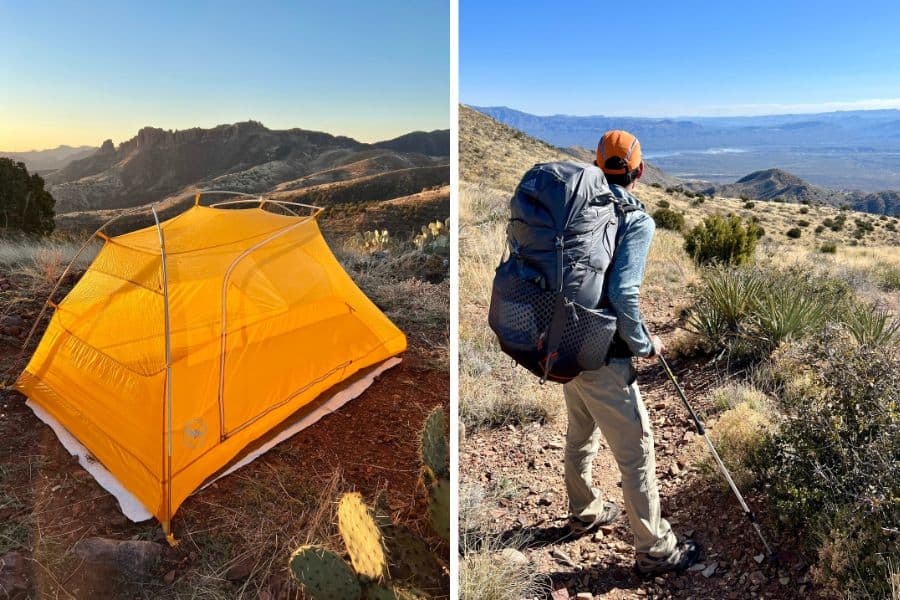
You’ve planned your trip, packed your bags, and you’re ready to go.
But wait up – there are a couple more things I have to tell you before you take off.
So listen up and take notes, because it’s super important you keep these things in mind while you’re on your wild camping adventure.
Keep An Eye On The Weather Forecast
The weather plays a big role in your camping trip. So, it’s important to know what kind of weather conditions you can expect throughout your trip.
Check the weather forecast regularly in the weeks and days leading up to your trip, to keep track of any possible changes.
But you should also check the weather regularly during your trip. Blue skies can turn to dark clouds in an instant, and you don’t want to be caught in a storm while you’re hiking up a mountain. So, to make sure that doesn’t happen – keep track of the forecast.
Be Prepared For Wildlife Encounters
One thing you should definitely do before any camping trip is familiarize yourself with the wildlife you might encounter.
There might be bears, snakes, or other potentially dangerous animals in the area you’re visiting. If there are, you’ll need to take a few precautions in case you run into some company.
Bear proof canisters are a must when you’re wild camping in bear country. Also, it’s a good idea to have some bear spray on hand in case of emergencies.
As far as snakes are concerned, campfire smoke does a pretty good job at keeping them away. But, if you want to be extra safe, you can pour some white vinegar in a big circle around your campsite. This prevents snakes from entering, because they’re unlikely to slide over the vinegar.
And don’t feed the wildlife!
No matter how cute or convincing the critters you come across might be, you should never give them your food. Feeding wildlife causes a range of serious problems, and it isn’t good for the animals either. So, resist the urge and keep your food to yourself.
Don’t Play With Fire
You should always be careful when you’re lighting a campfire. But when you’re lighting a campfire while you’re free camping in the wilderness, you need to be extra careful.
Wildfires are a serious issue, and a lot of them are started by accident.
Make sure that your fire pit is large enough to contain your campfire, and never light a campfire in windy weather conditions. The wind can carry burning embers onto nearby vegetation, your gear, and your skin.
Never leave your campfire unattended – not even for a couple of minutes.
And always make sure to have a large amount of water on standby in case you need to extinguish the fire quickly.
When you’re putting out your campfire, pour water over the coals and stir them with a large stick, to make sure none of the coals at the bottom stay lit. Never go to sleep while your campfire is still burning.
Always put it out, and always use water to do it.
How To Respect Nature While Wild Camping
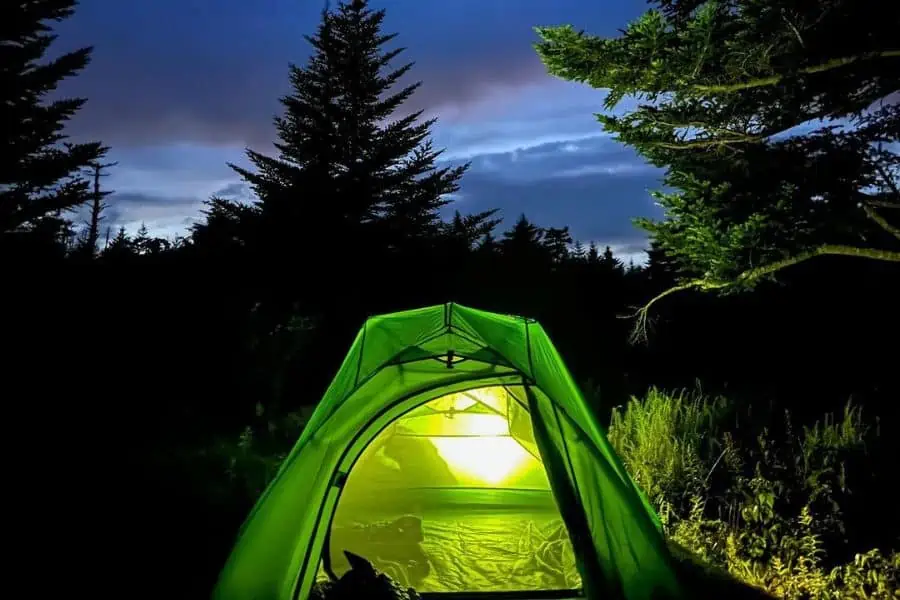
There are lots of things you can do while you’re free camping to make sure you have as little impact on your surroundings as possible.
First and foremost, if you haven’t already done so, get acquainted with the Leave No Trace principles. These 7 principles will give you all the information you need to respect the environment during your trip.
From campsite selection, to waste disposal, to wildlife and campfire impacts, these principles cover every aspect of camping there is.
As long as you stick to them, you can rest with a clear conscience knowing you didn’t do any unnecessary harm to the nature around you.
The Bottom Line
Like I said, wild camping is where it’s at.
There’s no greater feeling of freedom than venturing off into the wild and setting up camp under the stars, with nothing and nobody around you for miles.
If you’re planning a free camping trip, keep these tips in mind and you’re sure to have a great time.
To find out more about other interesting camping styles, check out this article I wrote about 13 awesome types of camping.


